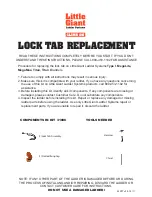
7
B. WORK SITE GEOMETRY:
The use of the Ladder FAS must be consistent with
the geometric requirements stated in the associated manufacturer’s instruction
manuals. Check for obstructions or sharp edges in the work path. Avoid working
where the user may swing and hit an object, or where lines may cross or tangle
with that of another worker.
C. RESCUE:
A means of dealing with an accident or emergency must be planned
in advance. Response time can play an important role in the survival of
an injured worker. Users of this equipment must be trained in emergency
procedures.
The owner’s organization must provide the User Instruction Manual to any user
of this equipment or to any rescuer.
3.3 REQUIREMENTS FOR PERSONAL FALL ARREST SYSTEMS (PFAS):
PFAS used
with the Ladder FAS must meet applicable OSHA and CE Fall Arrest Requirements:
OSHA Models
CE Models
8517714
8517718
8530652
8530682
8567715
8517715
8517719
8530658
8530683
8567717
8517716
8530555
8530659
8567719
8517717
8530584
8530674
900 lbf (4 kN)
1350 lbf (6 kN)
• The PFAS should be rigged to minimize any potential free fall and never allow
a free fall greater than 6 ft. (1.8 m). The PFAS used with this equipment
are required to include a full body harness as the body support component.
PFAS’s that incorporate full body harnesses must maintain fall arrest forces
below 1,350 lbs. (6.0 kN) and arrest the fall within 42 in. (1.1 m). Body belts,
unless incorporated into a full body harness, are not allowed for use with this
equipment.
A typical PFAS includes a full body harness, connecting subsystem or
component (self retracting lifeline or shock absorbing lanyard), and the
necessary connectors to couple the system together.
• PFAS may only be attached to the Ladder FAS at designated locations. See
Section 3.5
WARNING:
Read and follow manufacturer’s instructions for the personal fall arrest equipment
selected for use with the Ladder FAS.
IMPORTANT:
Body belts are not allowed for free fall situations. Bodybelts increase the risk of
injury during fall arrest in comparison to a full body harness. Limited suspension time and the
potential for improperly wearing a body belt may result in added danger to the user’s health.
3.4 TRAINING:
It is the responsibility of the user to assure they are familiar with
these instructions, and are trained in the correct care and use of this equipment.
User must also be aware of the operating characteristics, application limits, and
the consequences of improper use of this equipment.
IMPORTANT:
Training must be conducted without exposing the trainee to a fall hazard. Training
should be repeated on a periodic basis.



























